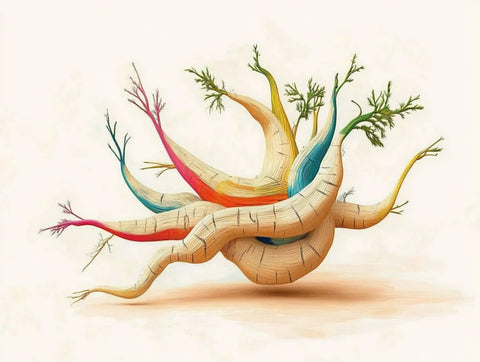Want to join the club?
Let’s start by talking about why menstrual cramps happen in the first place.
Period cramps happen mostly because of prostaglandins. These are hormone-like substances that trigger the uterus to contract in order to shed its lining. High levels of prostaglandins can lead to stronger and more painful contractions. These contractions also reduce blood flow to the uterine tissues, which contributes to discomfort. Menstruation also involves a natural inflammatory response as the body works to clear out the uterine lining, making pain and sensitivity worse during this time.
That's why CBD is great for helping alleviate period cramp pain as it both helps reduce inflammation and targets the production of prostaglandins. It’s also one of the reasons we use it as a base in our cycle health line, particuarly in products such as happy period.
Below is a look at how hemp, especially CBD (cannabidiol), can help with menstrual pain. It will also discuss its historical uses.
A Brief History of Hemp and Menstrual Cramps
Hemp has been used for centuries in treating various medical conditions like menstrual cramps. The first recorded use of hemp for menstrual cramp relief dates back centuries and can be traced all the way back to ancient China. Traditional Chinese medicine (TCM) documents the early use of hemp as a natural remedy to reduce menstrual discomfort. The seeds and flower were highly known for their therapeutic properties and were commonly prescribed by Chinese herbalists to women experiencing menstrual pain.
In the West, the use of hemp and cannabis for the treatment of menstrual cramps emerged during the 19th century. In this era, cannabis was included in various medical preparations and was commonly used to alleviate a range of ailments, including menstrual pain. The treatment gained recognition and popularity due to its reported effectiveness in providing relief from menstrual cramps. One notable figure associated with the use of cannabis tincture for menstrual cramp relief is Dr. J. Russell Reynolds, who served as Queen Victoria's personal physician. Dr. Reynolds prescribed cannabis tincture to Queen Victoria to address her menstrual discomfort. This endorsement by a prominent physician and the Queen's documented use of cannabis tincture for menstrual pain brought attention to its potential benefits.
It's important to note that our understanding of cannabis and its therapeutic properties has come a long way since the 19th century. Its use was greatly stifled by the ongoing war on drugs but given the wide ranging relief, the use never fully disappeared. Today, there is ongoing scientific research and interest in the potential benefits of cannabinoids, including CBD, for menstrual pain.
Understanding the Scientific Basis of Cannabinoids and Menstrual Cramp Relief
Cannabinoids have demonstrated effectiveness in providing relief from menstrual cramps through two primary mechanisms. Firstly, they reduce prostaglandins, which contribute to heightened cramp levels. Secondly, cannabinoids seem to inhibit vanilloid receptors, crucial pain signaling pathways.
The Regulation of Prostaglandin Production
Firstly, CBD has been found to reduce the production of prostaglandins, which are believed to be responsible for causing higher levels of cramps. Prostaglandins are hormone-like compounds that are released by the cells in the lining of the uterus during menstruation. They stimulate uterine contractions and can cause inflammation, leading to increased pain and discomfort. Cannabinoids, such as CBD, have been shown to modulate the production and release of prostaglandins, thereby reducing their levels and mitigating the intensity of menstrual cramps.
The Interaction with Pain Pathways
Secondly, cannabinoids exert their analgesic effects by interacting with vanilloid receptors, particularly the vanilloid receptor 1 (TRPV1). Vanilloid receptors are a type of receptor involved in pain signaling in the body. When activated, they transmit pain signals to the brain, resulting in the perception of pain. Cannabinoids, including both CBD and THC (tetrahydrocannabinol), have been found to inhibit the activation of vanilloid receptors, thereby reducing the transmission of pain signals. This inhibition leads to a decrease in pain sensitivity and can help alleviate the severity of menstrual cramps.
By targeting both prostaglandin production and vanilloid receptors, cannabinoids offer a multifaceted approach to managing menstrual cramps. These mechanisms provide potential explanations for the effectiveness of cannabinoids in providing relief and offer promising avenues for further research and the development of cannabinoid-based treatments for menstrual cramp relief.
The Advantages of Cannabinoids vs NSAIDS
NSAIDs (nonsteroidal anti-inflammatory drugs), such as Ibuprofen or Midol, are commonly used for pain relief, including menstrual cramps. While they are generally considered safe when used as directed, they have been found to have potential side effects. On the other hand, hemp derived cannabidiol products are generally regarded as having a favorable safety profile, with fewer known side effects compared to NSAIDs. The following are three main reasons why a full-spectrum CBD product would be potentially more favorable that taking an NSAID:
Gastrointestinal (GI) tolerance
CBD is well-tolerated by the GI tract in most individuals. It does not typically cause the same level of stomach irritation or ulcers associated with NSAIDs. This makes it a possibly safer option for individuals who are prone to GI issues or have a history of GI complications.
Reduced risk of bleeding
Unlike NSAIDs, CBD does not interfere with blood clotting or platelet function, reducing the risk of bleeding and related complications. This can be particularly beneficial for individuals who are at a higher risk of bleeding or are taking other medications that can impact clotting.
Overall side effect profile
CBD is generally associated with mild and transient side effects. These can include dry mouth, fatigue, and changes in appetite. However, these side effects are typically mild in nature and well-tolerated by most individuals. Compared to the potential risks and side effects associated with long-term NSAID use, CBD may offer a more favorable safety profile.
Why Use a Full-Spectrum CBD Product
We strongly believe in the power of the Entourage Effect, which suggests that the combined effect of multiple compounds is greater than that of any single compound alone. Hemp, being a complex plant, contains a diverse array of beneficial compounds like cannabinoids, terpenes, flavonoids, and other phytochemicals. Each of these compounds carries its own therapeutic potential and can work together synergistically to enhance the overall benefits of hemp-based products.
When it comes to addressing menstrual cramps, the presence of these various compounds in hemp offers significantly more relief compared to using isolated compounds alone. That's why we advocate for utilizing full-spectrum CBD products, such as the ones we offer in our drops. Our full-spectrum CBD contains a wide range of cannabinoids, including CBG, CBC, and even THC (within the legal limits set by authorities).
While THC is often associated with its psychoactive properties, it also has therapeutic qualities that contribute to the overall potential of hemp.
Let’s Talk About THC
THC has shown significant promise in pain relief. Although THC is known for getting you high, the amounts present in our full-spectrum CBD are within the federally allowed limits, ensuring a safe and controlled experience. THC (tetrahydrocannabinol) plays a significant role in aiding pain relief as it seems to act through several mechanisms:
Analgesic properties: THC has been recognized for its potential analgesic (pain-relieving) effects. It interacts with the body's endocannabinoid system, including cannabinoid receptors (CB1 and CB2), which are involved in pain perception. By activating these receptors, THC may modulate pain signaling and reduce the sensation of pain associated with menstrual cramps.
Muscle relaxation: THC can relax muscles which helps reduce the contractions and tension that often come with menstrual cramps. By promoting muscle relaxation, THC may provide relief from cramp-related discomfort.
Mood enhancement: Menstrual cramps can cause physical pain and mood changes. THC is a psychoactive compound that may improve mood as it can help reduce emotional symptoms linked to menstruation. This could offer a more complete way to relieve menstrual cramps.
At the end of the day we believe that using the full potential of hemp means using many compounds, including THC. This approach, supported by the Entourage Effect, can offer better benefits and more effective relief. This is especially true for pain and conditions like menstrual cramps.



